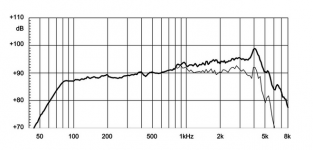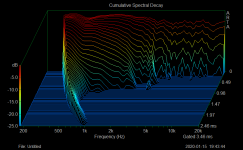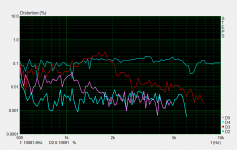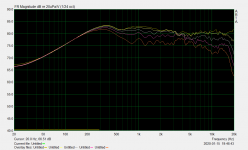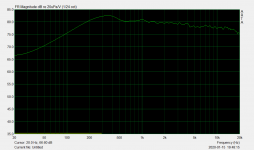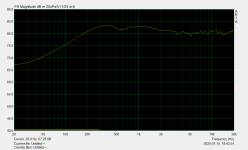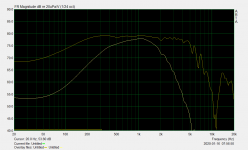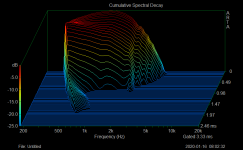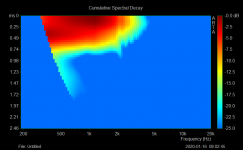The filtering is complicated. The midrange response is flattened (with DSP) so that even the breakup is not present as peaks in the frequency response. So the on-axis frequency response follows almost textbook LR4 up to 5 kHz (after that point the response steepens as seen in the datasheet) in this case.
Otherwise if I disconnect the midrange, the high pitched unpleasantness still present in the same way. So I am 90% sure it's not the midrange driver the problem. The high frequencies are too sharp sometimes if I want to describe simply.
It might have to be like that anyway, but I don't like it.
Otherwise if I disconnect the midrange, the high pitched unpleasantness still present in the same way. So I am 90% sure it's not the midrange driver the problem. The high frequencies are too sharp sometimes if I want to describe simply.
It might have to be like that anyway, but I don't like it.
Last edited:
It may be worth noting that this nulls off-axis contributions and so ignores those variations. Sometimes treble quality is best judged when it has a well tempered midrange behind it.The filtering is complicated. The midrange response is flattened (with DSP) so that even the breakup is not present as peaks in the frequency response.
Hi Denes,
this seems to be an off-axis problem, causing to much treble at your listening place. A waveguide could solve the problem but to be honest, your tweeter is a very good one and so the problem should be fixed without a new construction.
Have you ever tried a speaker position, where the axis of the speakers are crossing in front of the sweet spot (RLX-geometry)?

Regards
Ludger
this seems to be an off-axis problem, causing to much treble at your listening place. A waveguide could solve the problem but to be honest, your tweeter is a very good one and so the problem should be fixed without a new construction.
Have you ever tried a speaker position, where the axis of the speakers are crossing in front of the sweet spot (RLX-geometry)?

Regards
Ludger
Hi Ludger!
I haven't tried a positioning like that LRX but looks interesting.
As for the waveguide, I needed to reduced the on-axis tweeter level to get a balanced sound at the listening spot. If the on-axis response is ruler flat then the in-room balance is way too lean.
I haven't tried a positioning like that LRX but looks interesting.
As for the waveguide, I needed to reduced the on-axis tweeter level to get a balanced sound at the listening spot. If the on-axis response is ruler flat then the in-room balance is way too lean.
Last edited:
When I look at the waterfall plots and step response plots on "hificompass" for a variety of tweeters, it looks to me that the ScanSpeak D3004 has a clean decay in the time domain. Whatever breakup modes are present, they must be very well damped, because they don't really show up in these plots. The CSD looks pretty good even when comparing to the ceramic and beryllium drivers (not quite as clean, but close). The 2nd and 3rd harmonic distortion are good also (above 3kHz) and compares well with the best.
I have always preferred metal dome tweeters, but this scanspeak D3004 looks quite nice to me.
My hunch is that this is actually a midrange issue. For example, if your mid is making 3rd harmonic distortion in the 1-2 kHz range, that will show up as noise in the 4-8 kHz region. 3rd HD is very noticeable, much more than 2nd HD... If this be the case, it does not matter that you filter the input to the mid driver to remove 4k to 8k input... the fact that you are sending it 1k-2k signal means it will very definitely produce noise in the 4k-8k range... again, assuming that your mid driver has a 3rd HD problem.
I have always preferred metal dome tweeters, but this scanspeak D3004 looks quite nice to me.
My hunch is that this is actually a midrange issue. For example, if your mid is making 3rd harmonic distortion in the 1-2 kHz range, that will show up as noise in the 4-8 kHz region. 3rd HD is very noticeable, much more than 2nd HD... If this be the case, it does not matter that you filter the input to the mid driver to remove 4k to 8k input... the fact that you are sending it 1k-2k signal means it will very definitely produce noise in the 4k-8k range... again, assuming that your mid driver has a 3rd HD problem.
I'm just eating popcorn on the sideline at this point, because I am not getting that lightbulb moment... 
Those look very good measurements. Presumably you have a big 33uF capacitor in front of the tweeter to protect from switch-on thumps from the DSP/Amps.
Troels' CSD is much the same, so it looks like not a fault:
SS-domes
I see he uses 2kHz 2nd order and an Fs notch in the Jenzen Illuminator:
Jenzen-Illuminator
Which actually suggests the tweeter isn't struggling.
The mid seems to have a nasty peak at 4kHz:
Eighteen Sound - Professional loudspeakers
I think you'd notch that with an LCR in a passive crossover.
Best to sleep on these things, I think.
Those look very good measurements. Presumably you have a big 33uF capacitor in front of the tweeter to protect from switch-on thumps from the DSP/Amps.
Troels' CSD is much the same, so it looks like not a fault:
SS-domes
I see he uses 2kHz 2nd order and an Fs notch in the Jenzen Illuminator:
Jenzen-Illuminator
Which actually suggests the tweeter isn't struggling.
The mid seems to have a nasty peak at 4kHz:
Eighteen Sound - Professional loudspeakers
I think you'd notch that with an LCR in a passive crossover.
Best to sleep on these things, I think.
I have looked at your plots 3 times now, and I just don't see any possible source for a treble "hardness" or sibilance. The measurements look outstanding to me.
Perhaps you should just "voice" the speakers down a bit in the treble region? with DSP it is easy enough to shelve down the range from 4k-up by a 1/2 db and go from there... I know my personal preference with a wide dispersion speaker is that the response slopes down from 1k to 10k, such that with 1/2 or 1/3 octave smoothing the 10k level is down by 2 or 3 db. Oddly enough, with horn speakers I like a flat response... which is opposite of what I would expect.
Someone else mentioned that perhaps it is not your speaker. I am inclined to look past the Hypex amp, given the universal acclaim that the Ncore amps have recieved. Do you suspect your pre-amp could be the offender? are you primarilly listening to digital source, and if so... are you happy with your DAC? Have you tried analog source?
As an example, I recently noticed a drop in sound quality on my system, and I thought I might have capacitors going out of tolerance in my tweeter or midrange cross-over. It actually sounded like the tweeter diaphrams were separating from the voice coils. Before I could investigate, I changed out my CD player for a new one with a separate high performance DAC... Wow, I was shocked by the difference. The problem disappeared and my speakers sounded better than ever. Whatever was going bad in that old CD player made my speakers sound like they were having failure... !
So given how excellent your speakers/amps measure, perhaps you should look beyond them to the rest of your system...
Perhaps you should just "voice" the speakers down a bit in the treble region? with DSP it is easy enough to shelve down the range from 4k-up by a 1/2 db and go from there... I know my personal preference with a wide dispersion speaker is that the response slopes down from 1k to 10k, such that with 1/2 or 1/3 octave smoothing the 10k level is down by 2 or 3 db. Oddly enough, with horn speakers I like a flat response... which is opposite of what I would expect.
Someone else mentioned that perhaps it is not your speaker. I am inclined to look past the Hypex amp, given the universal acclaim that the Ncore amps have recieved. Do you suspect your pre-amp could be the offender? are you primarilly listening to digital source, and if so... are you happy with your DAC? Have you tried analog source?
As an example, I recently noticed a drop in sound quality on my system, and I thought I might have capacitors going out of tolerance in my tweeter or midrange cross-over. It actually sounded like the tweeter diaphrams were separating from the voice coils. Before I could investigate, I changed out my CD player for a new one with a separate high performance DAC... Wow, I was shocked by the difference. The problem disappeared and my speakers sounded better than ever. Whatever was going bad in that old CD player made my speakers sound like they were having failure... !
So given how excellent your speakers/amps measure, perhaps you should look beyond them to the rest of your system...
The measurements leave only one possible question, as to distortion from the mid driver. The resonant peak is still visible in the CSD, and is quite apparently contributing to the actual output. In a passive crossover I'd use a resonance trap across the low-pass inductor to kill that peak, but you don't have that option.
That apart, it is probably personal preference that might be the issue. I see nothing to complain about from the measurement either.
That apart, it is probably personal preference that might be the issue. I see nothing to complain about from the measurement either.
Please leave alone that mid breakup  , it's not visible in any way, the mid's frequency response is completely flat on-axis about to 4.5 kHz then shelves down, the small ridge around 3 kHz is a diffraction effect from the tweeter-baffle interaction, the same source as for the slight 4 kHz on-axis bump.
, it's not visible in any way, the mid's frequency response is completely flat on-axis about to 4.5 kHz then shelves down, the small ridge around 3 kHz is a diffraction effect from the tweeter-baffle interaction, the same source as for the slight 4 kHz on-axis bump.
These measurements are new with a slightly dialed down tweeter, it's definitely better to my ears than before. Maybe that's all what the speakers needed.
The room needs some absorbtion too instead of diffusion on every first reflection point, the wide dispersion excites the room more, I think.
These measurements are new with a slightly dialed down tweeter, it's definitely better to my ears than before. Maybe that's all what the speakers needed.
The room needs some absorbtion too instead of diffusion on every first reflection point, the wide dispersion excites the room more, I think.
Last edited:
Those measurements look nice.
What if your issue is an artefact of the DSP, caused by unvafourable parametrisation ?
Thanks!
What is unfavourable parametrisation?
Anyway, I think the source material is critical for me and the speakers maybe less forgiving.
- Status
- This old topic is closed. If you want to reopen this topic, contact a moderator using the "Report Post" button.
- Home
- Loudspeakers
- Multi-Way
- Treble, how to be good?
